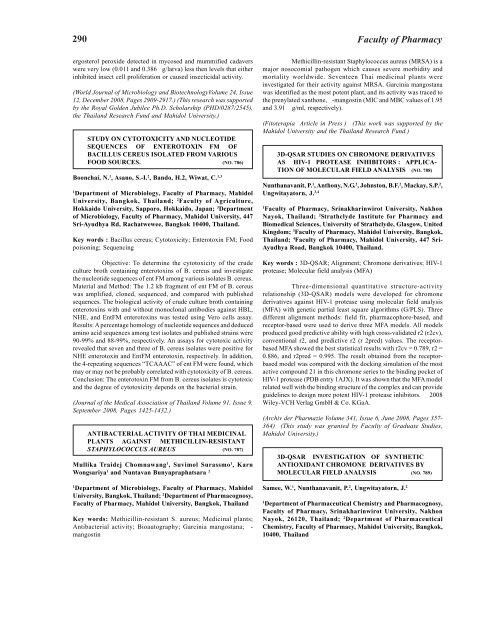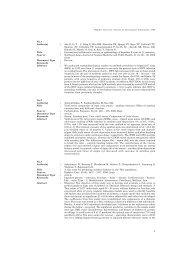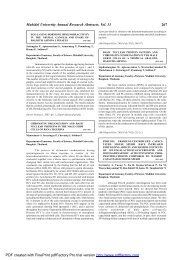Faculty of Pharmacy - Mahidol University
Faculty of Pharmacy - Mahidol University
Faculty of Pharmacy - Mahidol University
Create successful ePaper yourself
Turn your PDF publications into a flip-book with our unique Google optimized e-Paper software.
290 <strong>Faculty</strong> <strong>of</strong> <strong>Pharmacy</strong><br />
ergosterol peroxide detected in mycosed and mummified cadavers<br />
were very low (0.011 and 0.386 g/larva) less then levels that either<br />
inhibited insect cell proliferation or caused insecticidal activity.<br />
(World Journal <strong>of</strong> Microbiology and BiotechnologyVolume 24, Issue<br />
12, December 2008, Pages 2909-2917.) (This research was supported<br />
by the Royal Golden Jubilee Ph.D. Scholarship (PHD/0287/2545),<br />
the Thailand Research Fund and <strong>Mahidol</strong> <strong>University</strong>.)<br />
STUDY ON CYTOTOXICITY AND NUCLEOTIDE<br />
SEQUENCES OF ENTEROTOXIN FM OF<br />
BACILLUS CEREUS ISOLATED FROM VARIOUS<br />
FOOD SOURCES. (NO. 786)<br />
Boonchai, N. 1 , Asano, S.-I. 2 , Bando, H.2, Wiwat, C. 1,3<br />
1 Department <strong>of</strong> Microbiology, <strong>Faculty</strong> <strong>of</strong> <strong>Pharmacy</strong>, <strong>Mahidol</strong><br />
<strong>University</strong>, Bangkok, Thailand; 2 <strong>Faculty</strong> <strong>of</strong> Agriculture,<br />
Hokkaido <strong>University</strong>, Sapporo, Hokkaido, Japan; 3 Department<br />
<strong>of</strong> Microbiology, <strong>Faculty</strong> <strong>of</strong> <strong>Pharmacy</strong>, <strong>Mahidol</strong> <strong>University</strong>, 447<br />
Sri-Ayudhya Rd, Rachatwewee, Bangkok 10400, Thailand.<br />
Key words : Bacillus cereus; Cytotoxicity; Enterotoxin FM; Food<br />
poisoning; Sequencing<br />
Objective: To determine the cytotoxicity <strong>of</strong> the crude<br />
culture broth containing enterotoxins <strong>of</strong> B. cereus and investigate<br />
the nucleotide sequences <strong>of</strong> ent FM among various isolates B. cereus.<br />
Material and Method: The 1.2 kb fragment <strong>of</strong> ent FM <strong>of</strong> B. cereus<br />
was amplified, cloned, sequenced, and compared with published<br />
sequences. The biological activity <strong>of</strong> crude culture broth containing<br />
enterotoxins with and without monoclonal antibodies against HBL,<br />
NHE, and EntFM enterotoxins was tested using Vero cells assay.<br />
Results: A percentage homology <strong>of</strong> nucleotide sequences and deduced<br />
amino acid sequences among test isolates and published strains were<br />
90-99% and 88-99%, respectively. An assays for cytotoxic activity<br />
revealed that seven and three <strong>of</strong> B. cereus isolates were positive for<br />
NHE enterotoxin and EntFM enterotoxin, respectively. In addition,<br />
the 4-repeating sequences “TCAAAC” <strong>of</strong> ent FM were found, which<br />
may or may not be probably correlated with cytotoxicity <strong>of</strong> B. cereus.<br />
Conclusion: The enterotoxin FM from B. cereus isolates is cytotoxic<br />
and the degree <strong>of</strong> cytotoxicity depends on the bacterial strain.<br />
(Journal <strong>of</strong> the Medical Association <strong>of</strong> Thailand Volume 91, Issue 9,<br />
September 2008, Pages 1425-1432.)<br />
ANTIBACTERIAL ACTIVITY OF THAI MEDICINAL<br />
PLANTS AGAINST METHICILLIN-RESISTANT<br />
STAPHYLOCOCCUS AUREUS (NO. 787)<br />
Mullika Traidej Chomnawang 1 , Suvimol Surassmo 1 , Karn<br />
Wongsariya 1 and Nuntavan Bunyapraphatsara 2<br />
1 Department <strong>of</strong> Microbiology, <strong>Faculty</strong> <strong>of</strong> <strong>Pharmacy</strong>, <strong>Mahidol</strong><br />
<strong>University</strong>, Bangkok, Thailand; 2 Department <strong>of</strong> Pharmacognosy,<br />
<strong>Faculty</strong> <strong>of</strong> <strong>Pharmacy</strong>, <strong>Mahidol</strong> <strong>University</strong>, Bangkok, Thailand<br />
Key words: Methicillin-resistant S. aureus; Medicinal plants;<br />
Antibacterial activity; Bioautography; Garcinia mangostana; -<br />
mangostin<br />
Methicillin-resistant Staphylococcus aureus (MRSA) is a<br />
major nosocomial pathogen which causes severe morbidity and<br />
mortality worldwide. Seventeen Thai medicinal plants were<br />
investigated for their activity against MRSA. Garcinia mangostana<br />
was identified as the most potent plant, and its activity was traced to<br />
the prenylated xanthone, -mangostin (MIC and MBC values <strong>of</strong> 1.95<br />
and 3.91 g/ml, respectively).<br />
(Fitoterapia Article in Press ) (This work was supported by the<br />
<strong>Mahidol</strong> <strong>University</strong> and the Thailand Research Fund.)<br />
3D-QSAR STUDIES ON CHROMONE DERIVATIVES<br />
AS HIV-1 PROTEASE INHIBITORS : APPLICA-<br />
TION OF MOLECULAR FIELD ANALYSIS (NO. 788)<br />
Nunthanavanit, P. 1 , Anthony, N.G. 2 , Johnston, B.F. 2 , Mackay, S.P. 2 ,<br />
Ungwitayatorn, J. 3,4<br />
1 <strong>Faculty</strong> <strong>of</strong> <strong>Pharmacy</strong>, Srinakharinwirot <strong>University</strong>, Nakhon<br />
Nayok, Thailand; 2 Strathclyde Institute for <strong>Pharmacy</strong> and<br />
Biomedical Sciences, <strong>University</strong> <strong>of</strong> Strathclyde, Glasgow, United<br />
Kingdom; 3 <strong>Faculty</strong> <strong>of</strong> <strong>Pharmacy</strong>, <strong>Mahidol</strong> <strong>University</strong>, Bangkok,<br />
Thailand; 4 <strong>Faculty</strong> <strong>of</strong> <strong>Pharmacy</strong>, <strong>Mahidol</strong> <strong>University</strong>, 447 Sri-<br />
Ayudhya Road, Bangkok 10400, Thailand.<br />
Key words : 3D-QSAR; Alignment; Chromone derivatives; HIV-1<br />
protease; Molecular field analysis (MFA)<br />
Three-dimensional quantitative structure-activity<br />
relationship (3D-QSAR) models were developed for chromone<br />
derivatives against HIV-1 protease using molecular field analysis<br />
(MFA) with genetic partial least square algorithms (G/PLS). Three<br />
different alignment methods: field fit, pharmacophore-based, and<br />
receptor-based were used to derive three MFA models. All models<br />
produced good predictive ability with high cross-validated r2 (r2cv),<br />
conventional r2, and predictive r2 (r 2pred) values. The receptorbased<br />
MFA showed the best statistical results with r2cv = 0.789, r2 =<br />
0.886, and r2pred = 0.995. The result obtained from the receptorbased<br />
model was compared with the docking simulation <strong>of</strong> the most<br />
active compound 21 in this chromone series to the binding pocket <strong>of</strong><br />
HIV-1 protease (PDB entry 1AJX). It was shown that the MFA model<br />
related well with the binding structure <strong>of</strong> the complex and can provide<br />
guidelines to design more potent HIV-1 protease inhibitors. 2008<br />
Wiley-VCH Verlag GmbH & Co. KGaA.<br />
(Archiv der Pharmazie Volume 341, Issue 6, June 2008, Pages 357-<br />
364) (This study was granted by <strong>Faculty</strong> <strong>of</strong> Graduate Studies,<br />
<strong>Mahidol</strong> <strong>University</strong>.)<br />
3D-QSAR INVESTIGATION OF SYNTHETIC<br />
ANTIOXIDANT CHROMONE DERIVATIVES BY<br />
MOLECULAR FIELD ANALYSIS (NO. 789)<br />
Samee, W. 1 , Nunthanavanit, P. 2 , Ungwitayatorn, J. 2<br />
1 Department <strong>of</strong> Pharmaceutical Chemistry and Pharmacognosy,<br />
<strong>Faculty</strong> <strong>of</strong> <strong>Pharmacy</strong>, Srinakharinwirot <strong>University</strong>, Nakhon<br />
Nayok, 26120, Thailand; 2 Department <strong>of</strong> Pharmaceutical<br />
Chemistry, <strong>Faculty</strong> <strong>of</strong> <strong>Pharmacy</strong>, <strong>Mahidol</strong> <strong>University</strong>, Bangkok,<br />
10400, Thailand

















